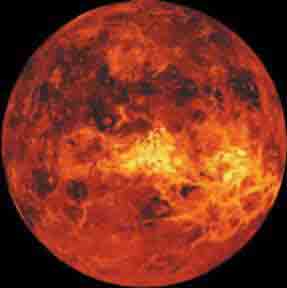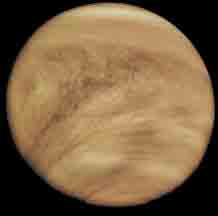|
         
> The Sun
> Mercury
> Venus
> Earth
> Mars
> Jupiter
> Saturn
> Uranus
> Neptune
> Pluto
> The 10th Planet?
> Asteroids
> Comets
> The 'Edge'
  
|
When Venus was
first studied in modern times, scientists saw a beautiful world that was
almost the size of Earth, and had a thick cover of clouds. The picture to
the right shows what Venus looks like when seen in ultra-violet light. For
years, Venus was called Earth's Sister Planet, and much popular science
and science fiction literature was devoted to what might lie below the
huge clouds. All that changed once scientists were able to measure what
those lovely clouds were made of - poisonous gases.
Venus's atmosphere is so thick that a barometric reading (a measure of
pressure) would be between 90 to 100 times higher than Earth's. Its
atmosphere is 97% carbon dioxide. This green-house gas retains almost all
of the heat Venus gets from the sun, and its surface temperature of 480 °C
(896 °F) is the same on both sides of the planet (contrast this with
Mercury, which has almost no atmosphere, where the day side is
approximately 530 °C (950 °F) hotter than the night side). This
temperature is hot enough to melt lead. The atmosphere is also rich in
sulfuric acid, so any type of precipitation would "burn" with acidity.
Also, the rocky surface of Venus is almost a liquid; it can be compared to
a candy bar that sat in the sun too long.
Scientists have mapped more of Venus' surface than that of the Earth.
While we cannot see beneath the clouds in visible light, we can bounce
radar off the planet's surface. Then, scientists use sophisticated
computers to decode the data and create a map. This is the same principle
that bats use to see in the dark, dolphins use to communicate, and we use
to map Earth's ocean floor. There is only a small section of Venus that
has yet to be mapped. The image to the left is a false-color image of what
Venus would look like if stripped of its clouds. The darker colors
indicate lower features, while the brighter colors indicate higher
features.
From the data currently available, Venus is a world composed of mountains,
flatlands, and valleys; much like the rugged terrain found on Earth. Also,
surprisingly, the Magellan spacecraft found a channel 6760 km (4200 miles)
long (that is longer than Earth's Nile River). The surface has relatively
few craters, which suggests that there was either recent or current
volcanic activity that has erased older craters.
Explorations
The USSR’s programme to penetrate the dense, cloud-covered
atmosphere of Venus met with great success. Venera 7 was launched in
August 1970 and survived long enough to transmit 23 minutes of temperature
data. Venera 8, launched in 1972, transmitted surface data that included
soil analysis. In October 1975, Veneras 9 and 10
 placed landers on
the surface; both survived for an hour and relayed the first photographs
of the Venusian surface. In 1978, Veneras 11 and 12 released probes that
landed on Venus on December 25 and 21, respectively. Both probes recorded
a pressure of 88 atmospheres and a surface temperature of 460° C (860° F).
On March 1 and 5, 1982, Veneras 13 and 14 landed on Venus. The craft
relayed photographs of the planet’s surface and analysed the chemical
composition of the atmosphere and soil. On October 10 and 14, 1983,
Veneras 15 and 16 entered orbit around Venus and returned radar images;
and in June 1985, Vegas 1 and 2, en route to Halley’s comet, released four
probes into the Venusian atmosphere. placed landers on
the surface; both survived for an hour and relayed the first photographs
of the Venusian surface. In 1978, Veneras 11 and 12 released probes that
landed on Venus on December 25 and 21, respectively. Both probes recorded
a pressure of 88 atmospheres and a surface temperature of 460° C (860° F).
On March 1 and 5, 1982, Veneras 13 and 14 landed on Venus. The craft
relayed photographs of the planet’s surface and analysed the chemical
composition of the atmosphere and soil. On October 10 and 14, 1983,
Veneras 15 and 16 entered orbit around Venus and returned radar images;
and in June 1985, Vegas 1 and 2, en route to Halley’s comet, released four
probes into the Venusian atmosphere.
The US probe Mariner 10, launched on November 3, 1973, flew past Venus on
February 5, 1974, and transmitted to Earth the first detailed photographs
of the top of the planet’s thick atmosphere. It was followed by Pioneer
Venus 1, an orbiter, and 2, which consisted of five atmospheric probes,
which were launched on May 20 and August 8, 1978, and reached Venus on
December 5 and 9, 1978. The orbiter mapped nearly the entire surface of
Venus, using radar, and the atmospheric probes analysed the composition
and movement of the atmosphere and its interaction with the stream of
atomic particles from the Sun known as the solar wind. The most recent US
probe, Magellan, was launched towards Venus from the Space Shuttle
Atlantis in May 1989 and transmitted high-resolution radar images of the
planet’s surface. [Top]
Unique Characteristics
Venus is a world that is best known for a "greenhouse
effect gone crazy." Its carbon dioxide-rich atmosphere used to let in the
sun's radiation, but it allowed little of it to escape. This raised the
temperature over a long period of time, until it got so hot that it
radiated as much energy as it received. It is now in an equilibrium
situation, just like all the other planets, but it's volumous blanket of
greenhouse gases allows it to maintain a very high temperature.
Venus is also well-known for its perpetual cloud cover. With clouds many
miles thick, they have been there since the world was discovered, and
probably will always remain. External Links
[Back] [Top] [Next] |

 placed landers on
the surface; both survived for an hour and relayed the first photographs
of the Venusian surface. In 1978, Veneras 11 and 12 released probes that
landed on Venus on December 25 and 21, respectively. Both probes recorded
a pressure of 88 atmospheres and a surface temperature of 460° C (860° F).
On March 1 and 5, 1982, Veneras 13 and 14 landed on Venus. The craft
relayed photographs of the planet’s surface and analysed the chemical
composition of the atmosphere and soil. On October 10 and 14, 1983,
Veneras 15 and 16 entered orbit around Venus and returned radar images;
and in June 1985, Vegas 1 and 2, en route to
placed landers on
the surface; both survived for an hour and relayed the first photographs
of the Venusian surface. In 1978, Veneras 11 and 12 released probes that
landed on Venus on December 25 and 21, respectively. Both probes recorded
a pressure of 88 atmospheres and a surface temperature of 460° C (860° F).
On March 1 and 5, 1982, Veneras 13 and 14 landed on Venus. The craft
relayed photographs of the planet’s surface and analysed the chemical
composition of the atmosphere and soil. On October 10 and 14, 1983,
Veneras 15 and 16 entered orbit around Venus and returned radar images;
and in June 1985, Vegas 1 and 2, en route to